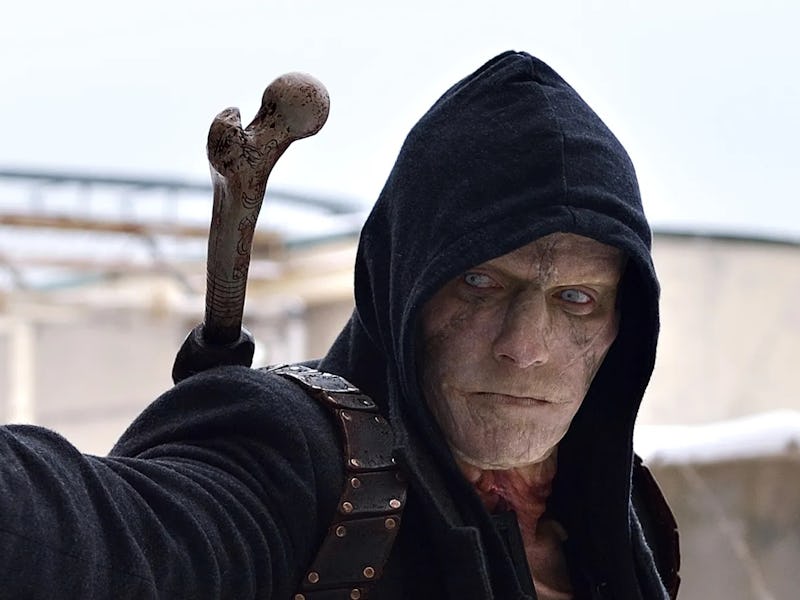Guillermo Del Toro’s Underrated Vampire Show Set the Bar for Small-Screen Horror
The Strain remains a hallmark of prestige horror TV.

In an era when so many prestigious shows are destined to die a too-early death, there’s something fascinating about The Strain. Guillermo del Toro’s television adaptation of the novel he co-wrote with author Chuck Hogan made a big splash when it was released in 2014, riding a wave of high-profile horror that followed the success of The Walking Dead. But even in the heyday of peak television, The Strain helped shape the template for the horror stories that would follow: creator-driven shows that were unapologetically scary.
While horror shows existed in the years before The Walking Dead, it was AMC’s zombie series that helped establish television as a viable medium for horror. Between 2010 and 2015, there was an explosion of shows unafraid to get bloody, ranging drastically in form from Hannibal to Penny Dreadful to Bates Motel. In interviews, FX head John Landgraf had spoken openly about the influence of The Walking Dead on long-form storytelling, admitting that it opened doors that had previously been closed. This created space for a vampire pathogen narrative to make the leap from page to screen.
But The Strain had something other horror shows lacked: the backing of a bona fide prestige filmmaker. In the time it took Del Toro and Hogan to hatch their master plan — turn the filmmaker’s failed pitch into a popular book series that would put them in the driver’s seat of any future adaptations — Del Toro had earned a spot as one of the highest-grossing filmmakers in Hollywood. Pacific Rim, the director’s kaiju feature, had earned more than $400 million at the box office, cementing del Toro’s unique appeal with both arthouse and commercial audiences.
It’s a formula the streamers would perfect in the following decade. Start with a high-profile adaptation, throw in a respected showrunner — in this case, Carlton Cuse of Lost fame — and top the whole thing off with the name recognition of a visionary filmmaker. With del Toro and Hogan determined to do their novels justice, there was little doubt that The Strain would lean into the elements that horror fans had come to expect. It was the kind of recipe for success that was ahead of its time.
So how does the first episode of The Strain fare, all these years later? In truth, surprisingly well.
The opening mystery of The Strain still intrigues.
From the jump, The Strain was a show straddling two worlds. Del Toro has spoken about his desire to anchor his vampire narrative in that of the procedural, and “Night Zero” makes a point early on to sink its teeth into the parallels between vampirism and a global pandemic. It’s smart to view the instigating event through the eyes of a Centers for Disease Control and Prevention (CDC) researcher; this allows The Strain to marry both modern and mythic, and establish how the show’s modern-day vampires may differ from what has come before.
Granted, any pandemic narrative will take on added weight post-2020, but The Strain is at its most fun when it blends horror with procedural storytelling. We are drawn to the mystery of what led Flight 753 to be abandoned on the tarmac and what threats the handful of survivors (“survivors”) pose to the rest of Manhattan. It’s also a nice touch that the spread of vampirism across the city is the result of failed bureaucracy and media pressure. The CDC is eventually strong-armed into letting the passengers break quarantine — a delightfully banal precursor to the apocalypse.
It also helps that the series also pulled no punches when it came to gore. Prior to the premiere episode, FX found itself courting controversy with a series of graphic billboards featuring a human eye being pierced by one of the show’s eponymous worms. And that was only a taste of the violence that would follow. The show introduces The Master, the vampire leader who sets his sights on Manhattan, with a prolonged head-crushing sequence that would make even the biggest In a Violent Nature skeptic smile.
The Strain’s first episode puts a new spin on vampire storytelling.
But for all its behind-the-camera prestige, there’s a whiff of anonymity about the pilot that even now is hard to shake. If the biggest narrative surrounding the show was an A-list filmmaker moving to the small screen, the cast never matched the star power of its executive producer. From a talent perspective, there’s absolutely nothing wrong with a cast that features actors like Corey Stoll and Kevin Durand — and David Bradley is a delight in his turn as the Van Helsing-esque Setrakian — but the biggest standout of the series might just be Regina King, who shows up for a handful of episodes as a high-level publicist and fixer for one of the survivors (“survivors”) of Flight 753.
Perhaps starting The Strain just in time for its 10-year anniversary is an embrace of horror’s television roots. Or maybe it’s just an exercise in small-screen historiography. Either way, there’s no denying that Guillermo del Toro’s series would serve as a harbinger of things to come — even if it never crossed over to become the Walking Dead-esque success that FX hoped for. While the pilot episode debuted to more than 3 million viewers, the show churned along for four seasons, never rising above the level of cable programmer. But The Strain remains a stepping stone in the realm of prestige horror television — and proof that the influence of talented horror storytellers went far beyond any one medium.